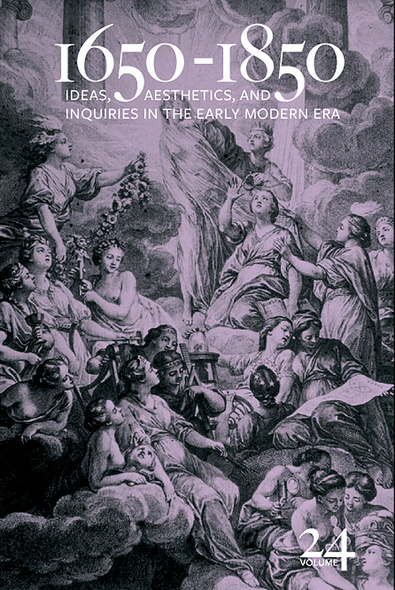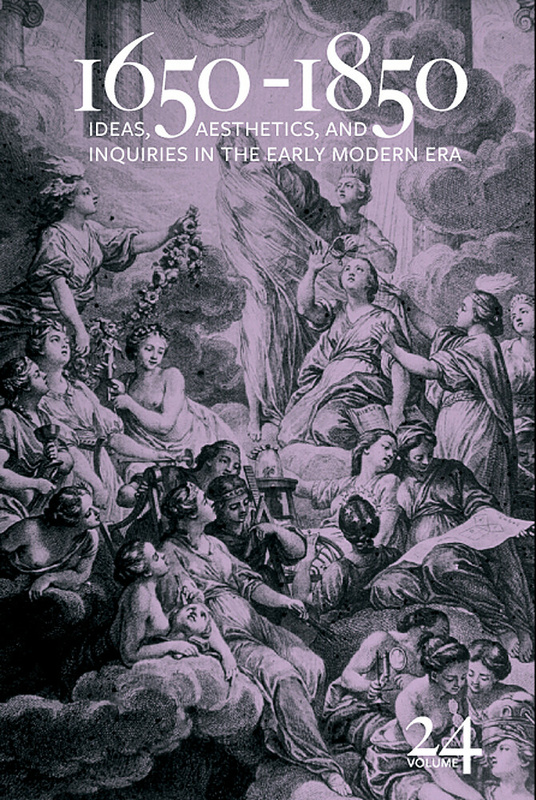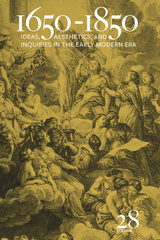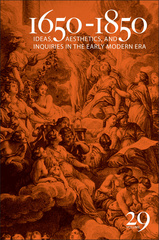1650-1850
Ideas, Aesthetics, and Inquiries in the Early Modern Era (Volume 24)
About the annual journal 1650-1850
1650-1850 publishes essays and reviews from and about a wide range of academic disciplines—literature (both in English and other languages), philosophy, art history, history, religion, and science. Interdisciplinary in scope and approach, 1650-1850 emphasizes aesthetic manifestations and applications of ideas, and encourages studies that move between the arts and the sciences—between the “hard” and the “humane” disciplines. The editors encourage proposals for “special features” that bring together five to seven essays on focused themes within its historical range, from the Interregnum to the end of the first generation of Romantic writers. While also being open to more specialized or particular studies that match up with the general themes and goals of the journal, 1650-1850 is in the first instance a journal about the artful presentation of ideas that welcomes good writing from its contributors.
First published in 1994, 1650-1850 is currently in its 24th volume.
ISSN 1065-3112.
Scholarly communities, especially those joined in eighteenth-century studies, can raise a shout (or glass) over the prospect of the annual 1650-1850’s future publication by Bucknell University Press. This will provide us with regular publication and broader distribution of the journal Kevin Cope has so impressively edited for over 20 years. With contributions from around the world, 1650-1850 has long been providing essays focused on fields as diverse as art and philosophy and others truly inter-disciplinary. It has carried many special issues on topics like 'Death and Dying in the Early Modern Era.' It has also distinguished itself by including lengthy essays and reviews. While 1650-1850 has always been an important annual for seventeenth-, eighteenth-, and nineteenth-century studies, its temporal focus is all the more valuable now that so much exciting research is being produced.
For more than two decades, 1650-1850 has offered its readers an inspiring example of what a scholarly annual concentrating on interdisciplinary and international topics can be. The work of seasoned scholars appears alongside that of 'mid-career' scholars and newly-minted PhDs, creating a heady variety of approaches and subject matter in every volume. The articles, the reviews, the 'special features,' and even the occasional 'Editor’s Choice' on underappreciated books always advance knowledge in large and small ways. Equally important, each contribution is typically written with verve and allusive pluckiness. There has never been anything doctrinaire about 1650-1850, other than an energy to display compelling new work to its best advantage. That Bucknell University Press has committed itself to this exciting annual is a cause for celebration.'
A good read and an intellectually responsible read, a worthwhile component of our literary public sphere that deserves our wellwishes.
“A Picture of My Mind, My Sentiments All Laid Open to Their View”: Lady Chudleigh’s Printed Verse, the Coterie Reader, and the Modern Editor
IGOR DJORDJEVIC
Addison’s Anglican Rationalism, Cato’s Tragic Flaw, and Stoicism
MORGAN STRAWN
Robert Harley and the Politics of Daniel Defoe’s Review, 1710–1713
ASHLEY MARSHALL
“All for Duty”: Dryden’s Critical Agenda in All for Love
PETER BYRNE
William Congreve as Satirist
PATRICIA GAEL
Classical Example and Gospel Rhetoric in the Sermons of In de pen dent Preacher Thomas Brooks
KEVIN JOEL BERLAND
Expanding Identity through Imagination; or, How Thomas Tryon Becomes the Marginalized
N. S. BOONE
Johnson and China: Culture, Commerce, and the Dream of the Orient in Mid- Eighteenth- Century England
GREG CLINGHAM
Technofacts: Christopher Smart and the Curiosity Cabinet WILLIAM HALL 243 Catesby’s Eclecticism and the Origin of His Style
ALEX SELTZER
SPECIAL FEATURE, EDITED BY WILLIAM STARGARD, PINE MANOR COLLEGE
“SACRED SPACES AND SPIRITUALITY IN THE LONG EIGHTEENTH CENTURY
Special feature introduction by William Stargard
Maria Clara Paulino, “Portuguese Religious Architecture, Beliefs and Practices in Northern European Travel Accounts (1750s–1850s)”
Donovan Tann, Hesston College, “Ascetic Cosmopolitanism: Imagining Religious Retreat in Mary Astell’s Serious Proposal to the Ladies, Parts I and II and Letters Concerning the Love of God”
Robin L. Thomas, “Convent and Crown: Redecorating Santa Chiara in Naples 1741–59"







